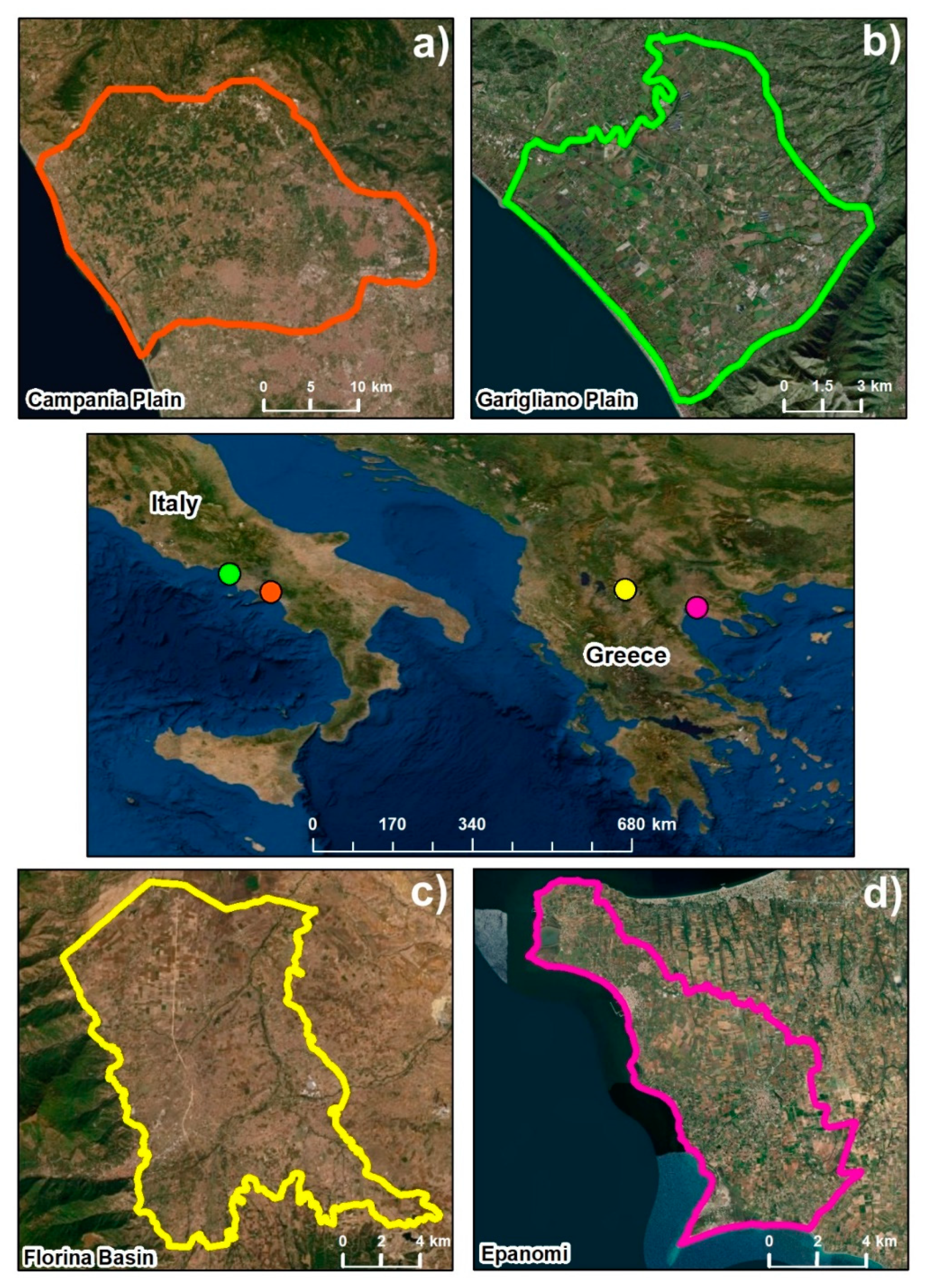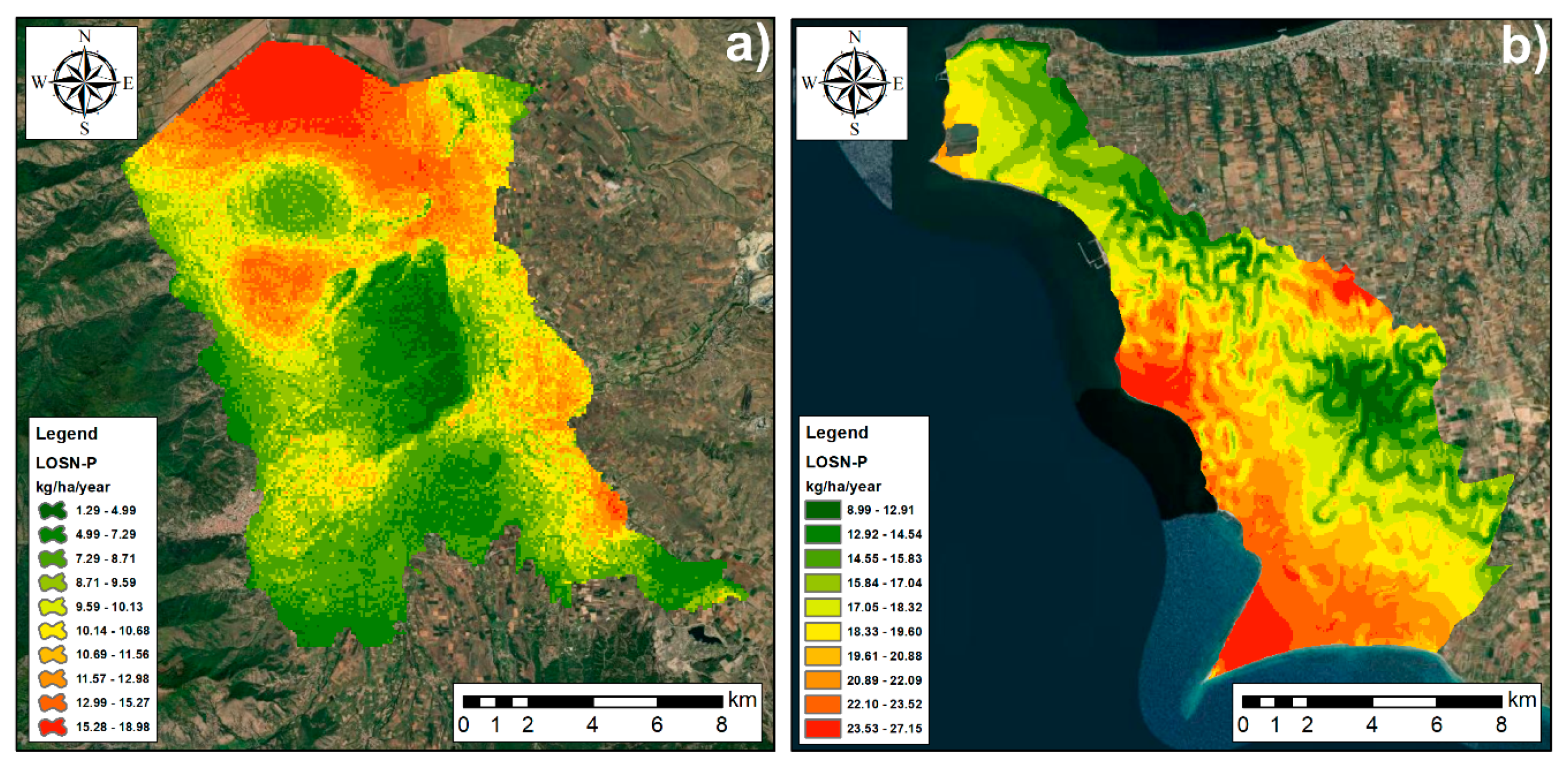The Importance of Incorporating Denitrification in the Assessment of Groundwater Vulnerability
Abstract
:1. Introduction
Denitrification in Groundwater Vulnerability Assessment
2. Materials and Methods
2.1. Study Areas
2.2. LOS Indices
3. Results and Discussion
3.1. Italian Application
3.2. The Greek Study Areas
3.3. Specific Vulnerability Assessment to NO3−
3.4. Application of SINTACS-SVN and DRASTIC-PA to Epanomi Coastal Area
4. Conclusions
Author Contributions
Funding
Conflicts of Interest
References
- Li, R.; Merchant, J.W. Modeling vulnerability of groundwater to pollution under future scenarios of climate change and biofuels-related land use change: A case study in North Dakota, USA. Sci. Total. Environ. 2013, 447, 32–45. [Google Scholar] [CrossRef] [PubMed] [Green Version]
- Miglietta, P.P.; Toma, P.; Fanizzi, F.P.; De Donno, A.; Coluccia, B.; Migoni, D.; Bagordo, F.; Serio, F. A Grey Water Footprint Assessment of Groundwater Chemical Pollution: Case Study in Salento (Southern Italy). Sustainability 2017, 9, 799. [Google Scholar] [CrossRef] [Green Version]
- Voudouris, K.; Panagopoulos, A.; Koumantakis, I. Nitrate pollution in the coastal aquifer system of the Korinthos prefecture (Greece). Glob. Nest. J. 2004, 6, 31–38. [Google Scholar]
- Directive 2006/118/EC of the European Parliament and the Council on the Protection of Groundwater against Pollution and Deterioration. Available online: https://eur-lex.europa.eu/LexUriServ/LexUriServ.do?uri=OJ:L:2006:372:0019:0031:EN:PDF (accessed on 27 February 2020).
- Busico, G.; Kazakis, N.; Cuoco, E.; Colombani, N.; Tedesco, D.; Voudouris, K.; Mastrocicco, M. A novel hybrid method of specific vulnerability to anthropogenic pollution using multivariate statistical and regression analyses. Water Res. 2020, 171, 115386. [Google Scholar] [CrossRef] [PubMed]
- Kazakis, N.; Voudouris, K. Groundwater vulnerability and pollution risk assessment of porous aquifers to nitrate: Modifying the DRASTIC method using quantitative parameters. J. Hydrol. 2015, 525, 13–25. [Google Scholar] [CrossRef]
- Gu, B.; Ge, Y.; Chang, S.X.; Luo, W.; Chang, S.X. Nitrate in groundwater of China: Sources and driving forces. Glob. Environ. Chang. 2013, 23, 1112–1121. [Google Scholar] [CrossRef]
- Burow, K.R.; Nolan, B.T.; Rupert, M.G.; Dubrovsky, N.M. Nitrate in Groundwater of the United States, 1991−2003. Environ. Sci. Technol. 2010, 44, 4988–4997. [Google Scholar] [CrossRef]
- Lockhart, K.; King, A.; Harter, T. Identifying sources of groundwater nitrate contamination in a large alluvial groundwater basin with highly diversified intensive agricultural production. J. Contam. Hydrol. 2013, 151, 140–154. [Google Scholar] [CrossRef]
- Costa, J.; Massone, H.; Martínez, D.; Suero, E.; Vidal, C.; Bedmar, F.; Martinez, D. Nitrate contamination of a rural aquifer and accumulation in the unsaturated zone. Agric. Water Manag. 2002, 57, 33–47. [Google Scholar] [CrossRef]
- Busico, G.; Cuoco, E.; Kazakis, N.; Colombani, N.; Mastrocicco, M.; Tedesco, D.; Voudouris, K. Multivariate statistical analysis to characterize/discriminate between anthropogenic and geogenic trace elements occurrence in the Campania Plain, Southern Italy. Environ. Pollut. 2018, 234, 260–269. [Google Scholar] [CrossRef]
- Busico, G.; Kazakis, N.; Colombani, N.; Mastrocicco, M.; Voudouris, K.; Tedesco, D. A modified SINTACS method for groundwater vulnerability and pollution risk assessment in highly anthropized regions based on NO3− and SO42−concentrations. Sci. Total. Environ. 2017, 609, 1512–1523. [Google Scholar] [CrossRef] [PubMed]
- Buczko, U.; Kuchenbuch, R.; Lennartz, B. Assessment of the predictive quality of simple indicator approaches for nitrate leaching from agricultural fields. J. Environ. Manag. 2010, 91, 1305–1315. [Google Scholar] [CrossRef] [PubMed]
- Debernardi, L.; De Luca, D.; Lasagna, M. Correlation between nitrate concentration in groundwater and parameters affecting aquifer intrinsic vulnerability. Environ. Earth Sci. 2007, 55, 539–558. [Google Scholar] [CrossRef]
- Cornelis, W.; Oltenfreiter, G.; Gabriels, D.; Hartmann, R. Splash-Saltation of Sand due to Wind-Driven Rain. Soil Sci. Soc. Am. J. 2004, 68, 32–40. [Google Scholar]
- Ranalli, A.J.; Macalady, D.L. The importance of the riparian zone and in-stream processes in nitrate attenuation in undisturbed and agricultural watersheds – A review of the scientific literature. J. Hydrol. 2010, 389, 406–415. [Google Scholar] [CrossRef]
- Hoang, L.; Van Griensven, A.; Mynett, A. Enhancing the SWAT model for simulating denitrification in riparian zones at the river basin scale. Environ. Model. Softw. 2017, 93, 163–179. [Google Scholar] [CrossRef]
- Huan, H.; Wang, J.; Teng, Y. Assessment and validation of groundwater vulnerability to nitrate based on a modified DRASTIC model: A case study in Jilin City of northeast China. Sci. Total. Environ. 2012, 440, 14–23. [Google Scholar] [CrossRef]
- Patrikaki, O.; Kazakis, N.; Voudouris, K. Vulnerability map: A useful tool for groundwater protection: An example from Mouriki basin, North Greece. Fresenius Environ. Bull. 2012, 8, 2516–2521. [Google Scholar]
- National Research Council. Groundwater Vulnerability Assessment: Predictive Relative Contamination Potential under Conditions of Uncertainty; National Academy Press: Washington, DC, USA, 1993; pp. 42–46. [Google Scholar]
- Mastrocicco, M.; Colombani, N.; Castaldelli, G. Direct measurement of dissolved dinitrogen to refine reactive modelling of denitrification in agricultural soils. Sci. Total. Environ. 2019, 647, 134–140. [Google Scholar] [CrossRef]
- Sun, X.; Bernard-Jannin, L.; Sauvage, S.; Garneau, C.; Arnold, J.; Srinivasan, R.; Pérez, J.M.S. Assessment of the denitrification process in alluvial wetlands at floodplain scale using the SWAT model. Ecol. Eng. 2017, 103, 344–358. [Google Scholar] [CrossRef]
- Aller, L.; Bennet, T.; Lehr, J.H.; Petty, R.J. DRASTIC: A Standardized System for Evaluating Groundwater Pollution Potential Using Hydrologic Settings; Robert, S., Ed.; Technical Report; U.S. EPA Report, 600/2-87/035; Kerr Environmental Research Laboratory: Ada, OK, USA, 1987. [Google Scholar]
- Civita, M.V. The Combined Approach When Assessing and Mapping Groundwater Vulnerability to Contamination. J. Water Resour. Prot. 2010, 2, 14–28. [Google Scholar] [CrossRef] [Green Version]
- Van Stempvoort, D.R.; Ewert, L.; Wassenaar, L.I. Aquifer vulnerability index: A GIS-compatible method for groundwater vulnerability mapping. Can. Water Resour. J./Rev. Can. Ressour. Hydr. 1993, 18, 25–37. [Google Scholar] [CrossRef] [Green Version]
- Stigter, T.; Ribeiro, L.; Dill, A.C. Evaluation of an intrinsic and a specific vulnerability assessment method in comparison with groundwater salinisation and nitrate contamination levels in two agricultural regions in the south of Portugal. Hydrogeol. J. 2005, 14, 79–99. [Google Scholar] [CrossRef]
- European Commission (2011) Report from the Commission to the Council and the European Parliament on Implementation of Council Directive 91/676/EEC Concerning the Protection of Waters Against Pollution Caused by Nitrates from Agricultural Sources Based on Member State Reports for the Period 2004–200.
- Padovani, L.M.; Trevisan, M. I nitrati di Origine Agricola Nelle Acque Sotterranee (Un Indice Parametrico per L’individuazione di Aree Vulnerabili); Pitagora Editrice: Bologna, Italy, 2002. [Google Scholar]
- Pisciotta, A.; Cusimano, G.; Favara, R.; Antonino, P.; Gioacchino, C.; Rocco, F. Groundwater nitrate risk assessment using intrinsic vulnerability methods: A comparative study of environmental impact by intensive farming in the Mediterranean region of Sicily, Italy. J. Geochem. Explor. 2015, 156, 89–100. [Google Scholar] [CrossRef]
- Matzeu, A.; Secci, R.; Uras, G. Methodological approach to assessment of groundwater contamination risk in an agricultural area. Agric. Water Manag. 2017, 184, 46–58. [Google Scholar] [CrossRef]
- Rizeei, H.M.; Azeez, O.S.; Pradhan, B.; Khamees, H.H. Assessment of groundwater nitrate contamination hazard in a semi-arid region by using integrated parametric IPNOA and data-driven logistic regression models. Environ. Monit. Assess. 2018, 190, 633. [Google Scholar] [CrossRef]
- Busico, G.; Mastrocicco, M.; Cuoco, E.; Sirna, M.; Tedesco, D. Protection from natural and anthropogenic sources: A new rating methodology to delineate “Nitrate Vulnerable Zones”. Environ. Earth Sci. 2019, 78, 104. [Google Scholar] [CrossRef]
- Castaldelli, G.; Mastrocicco, M.; Colombani, N.; Salemi, E.; Kazakis, N.; Voudouris, K.; Castaldelli, G. Assessment of the Intrinsic Vulnerability of Agricultural Land to Water and Nitrogen Losses via Deterministic Approach and Regression Analysis. Water Air Soil Pollut. 2011, 223, 1605–1614. [Google Scholar]
- Casciello, E.; Cesarano, M.; Pappone, G. Extensional detachment faulting on the Tyrrhenian margin of the southern Apennines contractional belt (Italy). J. Geol. Soc. 2006, 163, 617–629. [Google Scholar] [CrossRef]
- Mastrocicco, M.; Busico, G.; Colombani, N. Deciphering Interannual Temperature Variations in Springs of the Campania Region (Italy). Water 2019, 11, 288. [Google Scholar] [CrossRef] [Green Version]
- Kazakis, N.; Busico, G.; Colombani, N.; Mastrocicco, M.; Pavlou, A.; Voudouris, K. GALDIT-SUSI a modified method to account for surface water bodies in the assessment of aquifer vulnerability to seawater intrusion. J. Environ. Manag. 2019, 235, 257–265. [Google Scholar] [CrossRef] [PubMed]
- Leonard, R.A.; Davis, F.M.; Knisel, W.G. Groundwater Loading Effects of Agricultural Management Systems (GLEAMS). A tool to assess soil-climate-management-pesticide interaction; U. S. Department of Agriculture: Tifton, GA, USA, 1989.
- De Paz, J.M.; Ramos, C. Linkage of a geographical information system with the gleams model to assess nitrate leaching in agricultural areas. Environ. Pollut. 2002, 118, 249–258. [Google Scholar] [CrossRef]
- Castaldelli, G.; Castaldelli, G.; Colombani, N.; Mastrocicco, M. A combined methodology to assess the intrinsic vulnerability of aquifers to pollution from agrochemicals. Arab. J. Geosci. 2016, 9. [Google Scholar]
- Castaldelli, G.; Mastrocicco, M.; Colombani, N.; Salemi, E.; Castaldelli, G. Assessment of the intrinsic vulnerability of agricultural land to water and nitrogen losses: Case studies in Italy and Greece. In Proceedings of the International Association of Hydrological Sciences; Copernicus GmbH: Bologna, Italy, 2014; Volume 364, pp. 14–19. [Google Scholar]
- Di Gennaro, A. I Sistemi di Terra Della Campania; SELCA: Firenze, Italy, 2002. [Google Scholar]
- Caruso, A.; Boano, F.; Ridolfi, L.; Chopp, D.L.; Packman, A. Biofilm-induced bioclogging produces sharp interfaces in hyporheic flow, redox conditions, and microbial community structure. Geophys. Res. Lett. 2017, 44, 4917–4925. [Google Scholar] [CrossRef] [Green Version]
- Tomasek, A.; Kozarek, J.L.; Hondzo, M.; Lurndahl, N.; Sadowsky, M.J.; Wang, P.; Staley, C. Environmental drivers of denitrification rates and denitrifying gene abundances in channels and riparian areas. Water Resour. Res. 2017, 53, 6523–6538. [Google Scholar] [CrossRef]
- Voudouris, K.; Mandrali, P.; Kazakis, N. Preventing Groundwater Pollution Using Vulnerability and Risk Mapping: The Case of the Florina Basin, NW Greece. Geosciences 2018, 8, 129. [Google Scholar] [CrossRef] [Green Version]
- Cavero, J.; Plant, R.; Shennan, C.; Friedman, D.; Williams, J.; Kiniry, J.; Benson, V. Modeling nitrogen cycling in tomato–safflower and tomato–wheat rotations. Agric. Syst. 1999, 60, 123–135. [Google Scholar] [CrossRef]




© 2020 by the authors. Licensee MDPI, Basel, Switzerland. This article is an open access article distributed under the terms and conditions of the Creative Commons Attribution (CC BY) license (http://creativecommons.org/licenses/by/4.0/).
Share and Cite
Busico, G.; Kazakis, N.; Colombani, N.; Khosravi, K.; Voudouris, K.; Mastrocicco, M. The Importance of Incorporating Denitrification in the Assessment of Groundwater Vulnerability. Appl. Sci. 2020, 10, 2328. https://doi.org/10.3390/app10072328
Busico G, Kazakis N, Colombani N, Khosravi K, Voudouris K, Mastrocicco M. The Importance of Incorporating Denitrification in the Assessment of Groundwater Vulnerability. Applied Sciences. 2020; 10(7):2328. https://doi.org/10.3390/app10072328
Chicago/Turabian StyleBusico, Gianluigi, Nerantzis Kazakis, Nicolò Colombani, Khabat Khosravi, Konstantinos Voudouris, and Micòl Mastrocicco. 2020. "The Importance of Incorporating Denitrification in the Assessment of Groundwater Vulnerability" Applied Sciences 10, no. 7: 2328. https://doi.org/10.3390/app10072328




